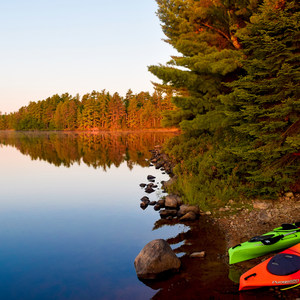You are here
Moose Lake in the Boundary Waters Canoe Area Wilderness is one of the most popular lakes because of it's proximity to Ely and the large amount of permits given daily. A large portion of the lake is located outside of the borders of the wilderness area. In this case, which means that motorized boat traffic is allowed on the lake. Although motor sizes are limited to 25 horsepower, outfitting companies are still able to transport canoers to and from certain locations inside the wilderness area. It is a unique exception to the normal rules of a designated Wilderness, where motorized traffic is normally prohibited.
Because of the high traffic in this area, surrounding lakes are filled with campsites. That gives campers plenty of options to explore within a relatively easy day of paddling. Uniquely shaped Ensign Lake has approximately 35 campsites on it. It is outside of the allowed motor routes, so engine noise is not really an issue (although on quiet nights, motor noise may be heard in the distance). The upside of Ensign Lake is that there is great fishing year round, and there are plenty of chances to find a campsite. The downside of a lake with high traffic, however, is that there is a lot of noise from other campers, making it one of the "louder" lakes in the Boundary Waters Canoe Area Wilderness. Also, because there are more campers, there are more food smells that can tend to attract more bears to the area. There have been reports of many bear sightings around this lake due to human influences. These black bear sightings are usually nothing to be too concerned with because the bears are only interested in food. Proper food handling will minimize unwanted interactions.
When travelling from Moose Lake to Ensign Lake, you will go through a secondary lake called Newfound Lake. After going through a shallow choke point 2 miles from the entry point on the north end of Moose, the lake becomes renamed to Newfound Lake. After another 2 miles of paddling the lake will spilt and lead toward the north and east. The north route will take you into Sucker Lake, Birch Lake, and onto the Prairie Portage Point on the Canadian border. The eastern route will take you to your first portage at a set of rapids. There is a 35-rod portage (1 rod equals 16.5 feet) that is flat and easily done in a few minutes; many motorized boat taxis drop off and pick up canoers at this point because this portion of the motor route ends here. After this portage you'll reach Splash Lake, and a short half-mile paddle later you'll reach your second portage. An 11-rod portage can be easily traversed by walking the canoe through the rapids depending on the time of year and water levels. You'll reach Ensign Lake and have plenty of options for exploration. One can continue on through Ensign to many other portages that lead to other routes.
The Boundary Waters present endless route options. Unlike a lot of hiking routes or rivers, a route can be modified with each trip. Entering at Moose Lake Entry Point #25, a canoer has the option to go many different ways to create their own adventure.
Logistics + Planning
Current Weather: Powered by Dark Sky



























Comments
Sign In and share them.